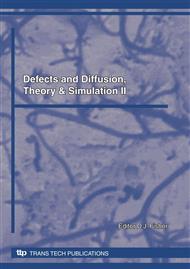[1]
N. Maluf, An introduction to microelectromechanical systems engineering, Artech House (2000).
Google Scholar
[2]
W. N. J. Sharpe, B. Yuan, R. Vaidyanathan and R. L. Edwards, Measurements of Young's modulus, Poisson's ratio, and tensile strength of polysilicon, Proceedings of the IEEE Micro Electro Mechanical Systems (MEMS), 424-429 (1997).
DOI: 10.1109/memsys.1997.581881
Google Scholar
[3]
D. A. LaVan and T. E. Buchheit, Testing of critical features of polysilicon MEMS in de Boer, Materials Science of Microelectromechanical System (MEMS) Devices II, 19-24 (2000).
Google Scholar
[4]
A. A. Wereszczak, A. S. Barnes and K. Breder, Probabilistic strength of {111} n-type silicon, Journal of Materials Science: Materials in Electronics, 11 (2000) 291-303.
DOI: 10.1023/a:1008973231053
Google Scholar
[5]
K. -S. Chen, S. M. Spearing and N. N Nemeth, Structural design of a silicon micro-turbo-generator, AIAA, 39 (2001) 720-8.
DOI: 10.2514/2.1367
Google Scholar
[6]
L. Li, Microscale tension test of single crystalline silicon, Master thesis, University of California, Los Angeles (2001).
Google Scholar
[7]
M. A. Cesare and R. H. Sues, "Profes probabilistic finite element system - bringing probabilistic mechanics to the desktop, Structural Dynamics and Materials Conference, 4 (1999) 3040-50.
DOI: 10.2514/6.1999-1607
Google Scholar
[8]
A. Haldar and S. Mahadevan, Probability, reliability, and statistical methods in engineering design, John Wiley (2000).
Google Scholar
[9]
D. S. Riha, B. H. Thacker, H. R. Millwater, Y. -T. Wu and M. P. Enright, Probabilistic engineering analysis using the NESSUS software, Structural Dynamics, and Materials Conference and Exhibit, 1-12 (2000).
DOI: 10.2514/6.2000-1512
Google Scholar
[10]
P. D. Spanos and B. A. Zeldin, Monte Carlo treatment of random fields: a broad perspective, Applied Mechanics Review, 51 (1998) 219-37.
DOI: 10.1115/1.3098999
Google Scholar
[11]
B. H. Thacker, D. P. Nicolella, S. Kumaresan, N. Yoganandan and F. Pintar, Probabilistic finite element analysis of the cervical spine, Math. Modeling and Sci. Computing, 13 (2001) 12-21.
DOI: 10.1115/imece2000-2598
Google Scholar
[12]
A. Haldar and S. Mahadevan, Reliability assessment using stochastic finite element analysis, John Wiley & Sons (2000).
Google Scholar
[13]
B. Thacker and H. Millwater, NESSUS: A New Tool for Safer Structures, Southwest Research Institute (1991).
Google Scholar
[14]
M. -H. Bao, Micro mechanical transducers : pressure sensors, accelerometers, and gyroscopes, Elsevier (2000).
DOI: 10.1016/s1386-2766(00)80022-5
Google Scholar
[15]
B. Stark, MEMS reliability assurance guidelines for space application, Overview, Southwest Research Institute (2002).
Google Scholar
[16]
O. Kraft, R. Schwaiger and W. D. Nix, Measurement of mechanical properties in small dimensions by microbeam deflection, Materials Research Society Symposium - Proceedings, 518 (1998) 39-44.
DOI: 10.1557/proc-518-39
Google Scholar
[17]
N. N. Nemeth, J. L. Palko, C. A. Zorman, O. Jadaan and J. S. Mitchell, Structural modeling and probabilistic characterization of MEMS pressure sensor membranes, ANSYS, Inc. (2001).
Google Scholar
[18]
W. N. Sharpe, K. T. Turner and R. L. Edwards, Tensile testing of polysilicon, Experimental Mechanics, 39 (1999) 210-6.
Google Scholar
[19]
T. Yi and C. J. Kim, Measurement of mechanical properties for MEMS materials, Measurement Science & Technology, 10 (1999) 706-16.
Google Scholar
[20]
R. V. Lust and Y. T. J. Wu, Probabilistic structural analysis - An introduction, Experimental Techniques, 22 (1998) 29-32.
Google Scholar


